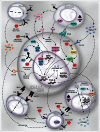Immunotherapy for cancer in the central nervous system: Current and future directions
- PMID: 27057463
- PMCID: PMC4801467
- DOI: 10.1080/2162402X.2015.1082027
Immunotherapy for cancer in the central nervous system: Current and future directions
Abstract
Glioblastoma multiforme (GBM) is the most common primary brain tumor in adults and still remains incurable. Although immunotherapeutic vaccination against GBM has demonstrated immune-stimulating activity with some promising survival benefits, tumor relapse is common, highlighting the need for additional and/or combinatorial approaches. Recently, antibodies targeting immune checkpoints were demonstrated to generate impressive clinical responses against advanced melanoma and other malignancies, in addition to showing potential for enhancing vaccination and radiotherapy (RT). Here, we summarize the current knowledge of central nervous system (CNS) immunosuppression, evaluate past and current immunotherapeutic trials and discuss promising future immunotherapeutic directions to treat CNS-localized malignancies.
Keywords: Brain metastases; IDO; T cell therapy; glioblastoma; glioma; vaccination.
Figures

References
-
- Ostrom QT, Bauchet L, Davis FG, Deltour I, Fisher JL, Langer CE, Pekmezci M, Schwartzbaum JA, Turner MC, Walsh KM et al.. The epidemiology of glioma in adults: a “state of the science” review. Neuro-Oncol 2014; 16:896-913; PMID:24842956; http://dx.doi.org/10.1093/neuonc/nou087 - DOI - PMC - PubMed
-
- Stupp R, Mason WP, van den Bent MJ, Weller M, Fisher B, Taphoorn MJ, Belanger K, Brandes AA, Marosi C, Bogdahn U et al.. Radiotherapy plus concomitant and adjuvant temozolomide for glioblastoma. New Eng J Med 2005; 352:987-96; PMID:15758009; http://dx.doi.org/10.1056/NEJMoa043330 - DOI - PubMed
-
- Krex D, Klink B, Hartmann C, von Deimling A, Pietsch T, Simon M, Sabel M, Steinbach JP, Heese O, Reifenberger G et al.. Long-term survival with glioblastoma multiforme. Brain 2007; 130:2596-606; PMID:17785346; http://dx.doi.org/10.1093/brain/awm204 - DOI - PubMed
-
- Shirai Y. On the transplantation of the rat sarcoma in adult heterogenous animals. Jap Med World 1921; 1:14-5
-
- Carson MJ, Doose JM, Melchior B, Schmid CD, Ploix CC. CNS immune privilege: hiding in plain sight. Immunological Rev 2006; 213:48-65; PMID:16972896; http://dx.doi.org/10.1111/j.1600-065X.2006.00441.x - DOI - PMC - PubMed
Publication types
Grants and funding
LinkOut - more resources
Full Text Sources
Research Materials
Miscellaneous
